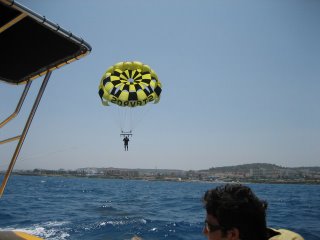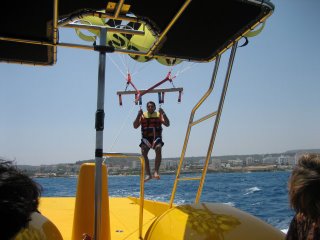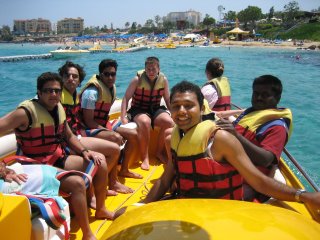Egypt Experience By Cruise
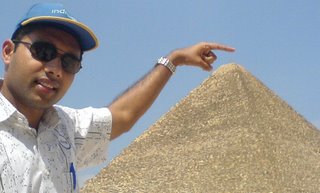 I went to Egypt on a cruise ship and visited The Great Pyramid of Giza, Sphinx, River Nile, Papyrus factory and Bazaar. I am back now from the most ancient civilization in the world and I am feeling on top of this world!!! Simply Awesome…the magnificence of Pyramids, mysteries of mummies, Pharaoh King Tutankhamun and his child-wife... Ankhesenamun. Everything King Tut used: chariots, throne, bed, shrine and even his slippers were solid gold…sometimes even hundreds of kgs. We visited Egyptian museum, had lunch and enjoyed belly-dance on beautiful Nile Cruise, went inside the magnanimous pyramids and Sphinx, and shopped in the Bazaar and Papyrus factory full with heckling vendors…and clicked everywhere legally…err sometimes illegally :P. Wherever you shop, whatever you buy…you just can’t live without a bargain in Egypt :-)
I went to Egypt on a cruise ship and visited The Great Pyramid of Giza, Sphinx, River Nile, Papyrus factory and Bazaar. I am back now from the most ancient civilization in the world and I am feeling on top of this world!!! Simply Awesome…the magnificence of Pyramids, mysteries of mummies, Pharaoh King Tutankhamun and his child-wife... Ankhesenamun. Everything King Tut used: chariots, throne, bed, shrine and even his slippers were solid gold…sometimes even hundreds of kgs. We visited Egyptian museum, had lunch and enjoyed belly-dance on beautiful Nile Cruise, went inside the magnanimous pyramids and Sphinx, and shopped in the Bazaar and Papyrus factory full with heckling vendors…and clicked everywhere legally…err sometimes illegally :P. Wherever you shop, whatever you buy…you just can’t live without a bargain in Egypt :-) 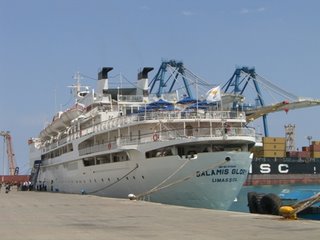
I am one out of 450 Indian software Engineers working in Cyprus, Europe for Amdocs. I with around five hundred people, mostly Europeans, boarded Salamis Cruise for Egypt on 24th Apr 2006 from Cyprus. We stayed in Egypt for 12 hours 7 AM to 7 PM. The luxurious Salamis cruise sailed from Limassol in the afternoon and the next morning we were anchored on Port Said (‘a’ pronounced as in balm and ‘i’ as in seed) [say it again and please pronounce it correctly this time J], the entry port to Egypt, named after one of their presidents: Said Pasha. They have another city named after his successor Ismail Pasha: Ismailia City. I guess my next generation would be hearing Bushy City in Texas…and Port Kalam and Port Vajpayee in India!! Anyways, without digressing into a never-returning maze of BDAP, I would like to tell you guys that the sense of achievement from Egypt Trip is stupendous. The most ancient civilization, creators of the only standing wonder of the world: the pyramids, the inventors of paper, the most mysterious necropolis revealing the mystifying mummies, the longest river in the world: Nile…the richest treasures ever discovered, the legends of the curse of Tutankhamun’s mummy, the resultant mysterious deaths of Howard Carter’s crew who discovered it…each and every single entity of my visit was grand!!
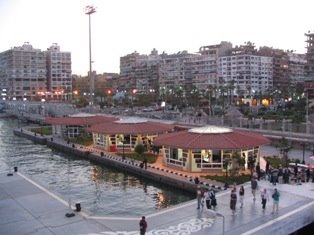
Cairo had triple bomb blasts in Dahab (Sinai Peninsula, Eastern Egypt) killing at least fifty people two days before our visit (23rd Apr) because of which there was heavy security. Moreover, we were frightened because our tour manager’s name was Osama :-). One policeman was in each of the six YouGoEgypt buses, an Egyptian company in partnership with Salamis. The caravan of six buses was covered by police vehicles and finally covered by police mobikes. Our policeman, named Samy Farhaad was a Mubarak Police Academy (named after President Hosni Mubarak) alumnus and secretly told me with a smirk about his two wives ;-). After every (Photograph: Port Said where our cruise anchored) ten kilometers there was a police checkpoint and I could see Samy talking on his walkie-talkie before each checkpoint came and smiling to the policemen on the checkpoint. Tourism is the second biggest source of income to Egypt after Industry and Foreign Trade. Revenue from Suez Canal and Oil exports come third and fourth. The Government of Egypt took it upon themselves for the security of tourists.
 This lady was superb. Our guide Marwah Hussein did her Masters from Cairo University in Tourism and wrote a thesis on something fundoo like relevance of archaeological artifacts on tourism and economy. An impressive lady, superb speaker, thinks on her feet, answered candidly most of my questions and automatically shakes your prejudices on condition of women in Muslim countries! I loved her ‘Raja-Rani’ stories about King Tut and his beloved wife, the evil priest, Tut’s father Akhenaten’s romance with founding a new monotheistic religion, his wife’s quest to build now-famous shrine to ensure that they are united in after-life.
This lady was superb. Our guide Marwah Hussein did her Masters from Cairo University in Tourism and wrote a thesis on something fundoo like relevance of archaeological artifacts on tourism and economy. An impressive lady, superb speaker, thinks on her feet, answered candidly most of my questions and automatically shakes your prejudices on condition of women in Muslim countries! I loved her ‘Raja-Rani’ stories about King Tut and his beloved wife, the evil priest, Tut’s father Akhenaten’s romance with founding a new monotheistic religion, his wife’s quest to build now-famous shrine to ensure that they are united in after-life.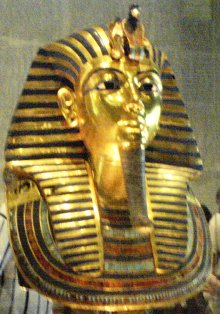 There exist three messages sent by her outside Egypt to find help: “I will marry any soldier but not this priest”, “I will marry any servant but not the priest”, “I will die but not marry this priest”; which point towards how she resisted marrying evil priest after the mysterious death of Tut at age of 18. Priests were against the royal family mainly because of Tut’s father’s attempts to found a religion with one God, against the then convention of several Gods and Goddesses. Tut was made the king at age of 9 and died mysteriously at 18, after which the priest proposed his wife. She hated the priest, however still married him…so that she could build her beloved husband’s shrine which would ensure their unity in after-life! (Left:
There exist three messages sent by her outside Egypt to find help: “I will marry any soldier but not this priest”, “I will marry any servant but not the priest”, “I will die but not marry this priest”; which point towards how she resisted marrying evil priest after the mysterious death of Tut at age of 18. Priests were against the royal family mainly because of Tut’s father’s attempts to found a religion with one God, against the then convention of several Gods and Goddesses. Tut was made the king at age of 9 and died mysteriously at 18, after which the priest proposed his wife. She hated the priest, however still married him…so that she could build her beloved husband’s shrine which would ensure their unity in after-life! (Left:<-- King Tut's Mask)

The Great Sphinx -->
At first view a pyramid from distance looks not much different from a mountain! Once near to them I felt so small and insignificant in front of their magnanimity. Egypt in total has 101 pyramids, the first run after the century was scored a few years back when archaeologists discovered 101st pyramid in Western Desert. Older pyramids were built around Cairo and not very far from civilization. However, when faced with attacks by tomb raiders, treasure-hunters and plunderers, later they started building them deep inside inhospitable western desert. Few of them were discovered totally covered with sand sometimes.
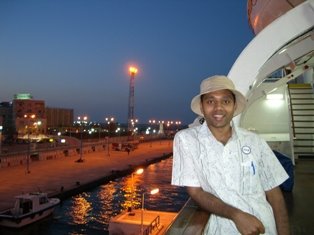 The Great Pyramid of Giza (aka Pyramid of Khufu or Pyramid of Cheops) is the biggest and is the only existing one of the Seven Wonders of the World. There is no official ranking between these seven. There are two major pyramids on Giza plateau: Khufu, and Khafre. Khafre is smaller than Khufu. Mekaure is third and smaller one. Sphinx is also located in Giza, which is body of lion representing strength and face of human representing intelligence; thus serving as guardian of the pyramids. Cairo, the biggest city of Middle East, I think, has grown to include Sphinx and these Pyramids now.
The Great Pyramid of Giza (aka Pyramid of Khufu or Pyramid of Cheops) is the biggest and is the only existing one of the Seven Wonders of the World. There is no official ranking between these seven. There are two major pyramids on Giza plateau: Khufu, and Khafre. Khafre is smaller than Khufu. Mekaure is third and smaller one. Sphinx is also located in Giza, which is body of lion representing strength and face of human representing intelligence; thus serving as guardian of the pyramids. Cairo, the biggest city of Middle East, I think, has grown to include Sphinx and these Pyramids now.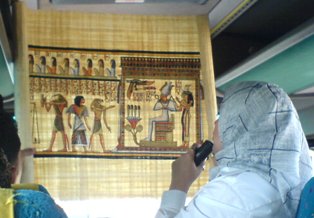
(Photograph: Port Said at night)
Marwah recommended us to buy ‘Kartoosh’ as the best souvenir from Egypt. Kartoosh is a gold amulet worn for luck, health, peace, etc.; reasons similar to Indians wearing several stones and metal combinations. She told us that gold is cheap in Egypt because Egypt is a land of gold with 300 gold mines. King Tut’s mask only had 25 kgs of gold! I purchased a gold ring made up of Kartoosh with my name written in Hieroglyphics and I am wearing it. From the government guaranteed papyrus factory I purchased two papyrus paintings depicting The Final Judgment. (photograph: Marwah showing Final Judgement Papyrus painting -->) The original Final Judgment papyrus painting is in Louvre Museum in Paris. Paper made from papyrus plant never decays.
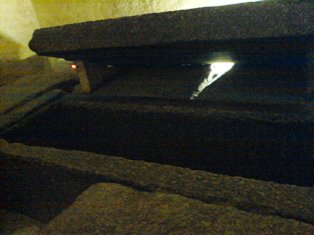 This was the core idea behind the Egyptian invention of paper. Papyrus plant looks like a thin bamboo stick with pulp inside the bark. If you look closer you will notice with serendipity that the stick’s base is pyramidal and tapers towards the upper end. Final Judgment depicts what happens to a person when he dies and his fate in his after-life is decided: heaven or hell! Several gods vote on his innocence. If there is a tie, his heart is taken out and weighed against a feather. If his heart is lighter he is judged innocent and gets paradise, else his heart is eaten by a jackal-god and he is deemed hell.
This was the core idea behind the Egyptian invention of paper. Papyrus plant looks like a thin bamboo stick with pulp inside the bark. If you look closer you will notice with serendipity that the stick’s base is pyramidal and tapers towards the upper end. Final Judgment depicts what happens to a person when he dies and his fate in his after-life is decided: heaven or hell! Several gods vote on his innocence. If there is a tie, his heart is taken out and weighed against a feather. If his heart is lighter he is judged innocent and gets paradise, else his heart is eaten by a jackal-god and he is deemed hell.(Photograph: Coffin inside The Great Pyramid which contained Mummy)
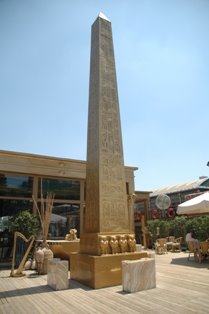 Symbology is strong in Egyptian culture. Lotus represents acceptance and peace, beetle being unisexual (can reproduce for itself… yes… without sex!!) for rebirth and continuity, cobra to punish, vulture for protection. Cobra and vulture are made out of gold on Tut’s tomb and the an interesting fact pointing towards truth of King Tut’s curse is that after Howard Carter took out and in effect disturbed Tut’s mummy, his canary was swollen by a cobra!
Symbology is strong in Egyptian culture. Lotus represents acceptance and peace, beetle being unisexual (can reproduce for itself… yes… without sex!!) for rebirth and continuity, cobra to punish, vulture for protection. Cobra and vulture are made out of gold on Tut’s tomb and the an interesting fact pointing towards truth of King Tut’s curse is that after Howard Carter took out and in effect disturbed Tut’s mummy, his canary was swollen by a cobra!(Photograph: Obelisk representing Sun God 'Ra' is strong in Egyptian Culture)
One thing that stood in complete contrast to European shops is the heavy-duty bargaining. All items, from souvenirs like small pyramids made of glass or wood, Tut’s fake artifacts, wooden statue of arguably the most beautiful ancient Egyptian ever: Queen Nefritis, stuffed camels, even the gold ‘Kartoosh’ sold in the so-called fixed-price-shops…all demand you to quote a price much lesser to the vendor, sometimes even 10 to 1!! My mother always bargained in all the places we visited in and around India: Kathmandu, Pokhra, Darjeeling, Jaipur, Palika Bazaar of Delhi, etc.etc.…she just loves to quote one-tenth of printed price and then bask in the glory of buying at a lesser price than everyone else ;) On the contrary, constant pestering from local sellers in Giza and Khafren, around pyramids and sphinx; and that too in the dry heat and blowing on the face sand-dust was grueling for me. Even the acclaimed sticky Indian haggling vendors are no match for them :D 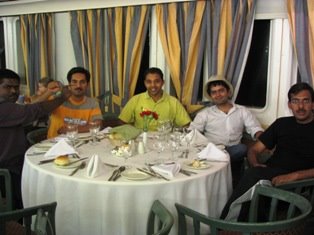

(Photograph: Welcome Dinner on Cruise)
Everything comes at a price! Well, we did pay in terms of hours (48) and pounds (135 CYP), however what matters to me the most is the hardship I endure. Like all journeys, this one was tiring too. Add to it the constant see-saw motion of the ship about both vertical and horizontal axes. The travel agent who gave me my cruise tickets although did advise me to take Stemetil: sea-sickness pills before boarding. However, I had never been out on a ship and definitely wanted to experience naturally all positives and negatives of it :P although it does not feel nice when you are sea-sick, and everybody else except you is enjoying in Casino Royale, Othellos Bar, Salaminia Lounge, Lido Cafe, Galaxias Disco, Library, Duty Free shop, Lido Verantah, Byzantium Dining Hall, cabarets, live music and dances…blah blah…all night! So, I gave in my arms and surrendered before the might of sea-sickness: took double pills, slept for a couple of hours and was back recharged with energy! 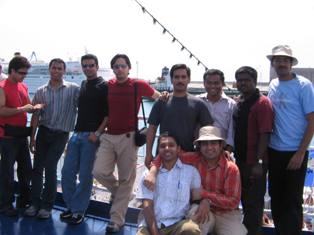 The dry heat of Egyptian desert is excruciating…hotter and more scorching than Indian summer, I am sure. Egypt is in complete contrast to Europe, au contraire with loads of similarities with India! India was founded as a republic in 1950 after freedom from Britain which is arguably credited to Gandhi. Nasser freed Egypt from Britain and in 1952 made it a republic. Nehru and Nasser started the Non-Aligned Movement together later on. Demographically also I could smell the same Indianness. Rural people live in thatched huts in sparsely populated area dependent on cattle and government, urban people live in flats in tall buildings working in private companies. Education is almost free, Cairo University is one of the best in (Photograph: Our Group on Deck)
The dry heat of Egyptian desert is excruciating…hotter and more scorching than Indian summer, I am sure. Egypt is in complete contrast to Europe, au contraire with loads of similarities with India! India was founded as a republic in 1950 after freedom from Britain which is arguably credited to Gandhi. Nasser freed Egypt from Britain and in 1952 made it a republic. Nehru and Nasser started the Non-Aligned Movement together later on. Demographically also I could smell the same Indianness. Rural people live in thatched huts in sparsely populated area dependent on cattle and government, urban people live in flats in tall buildings working in private companies. Education is almost free, Cairo University is one of the best in (Photograph: Our Group on Deck)Arab World and funded by the Egyptian government. Urban Egyptians speak English, although not as well as we Indians do! Nevertheless, Egypt is richer in monuments.
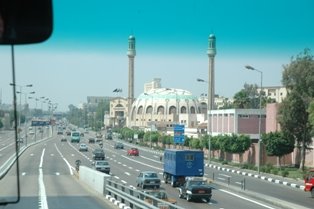 India has Tajmahal: eighth wonder; Egypt has Pyramid of Giza: the only wonder! India is hot, Egypt is hotter. :P India has problem with population, Egypt has problems with overpopulation and considers overpopulation as the single most important enemy! In general, Egyptians farmers, called ‘falaaheen’ in local Arabic, usually depicted wearing traditional robe: ‘Galaabiyaah’; which constitute 55% of population still have that negative mentality that more children will result in more help in farming and will support them in old age and procreate six to twelve children each. In contrast, Urban Egyptians are usually financially well-to-do and (Photograph: Cairo, the biggest city of Middle East and Africa) negligent of their rural compatriots, and there exists a divide, which sounded to me so familiar to the Indian scenario. Egyptians have lots of Gods with interesting legends…so do Indians, both have a superbly rich history, not-so-rich present and people in both countries are working hard towards a richer future. I wish both countries a wonderful future. Amen!!
India has Tajmahal: eighth wonder; Egypt has Pyramid of Giza: the only wonder! India is hot, Egypt is hotter. :P India has problem with population, Egypt has problems with overpopulation and considers overpopulation as the single most important enemy! In general, Egyptians farmers, called ‘falaaheen’ in local Arabic, usually depicted wearing traditional robe: ‘Galaabiyaah’; which constitute 55% of population still have that negative mentality that more children will result in more help in farming and will support them in old age and procreate six to twelve children each. In contrast, Urban Egyptians are usually financially well-to-do and (Photograph: Cairo, the biggest city of Middle East and Africa) negligent of their rural compatriots, and there exists a divide, which sounded to me so familiar to the Indian scenario. Egyptians have lots of Gods with interesting legends…so do Indians, both have a superbly rich history, not-so-rich present and people in both countries are working hard towards a richer future. I wish both countries a wonderful future. Amen!!
